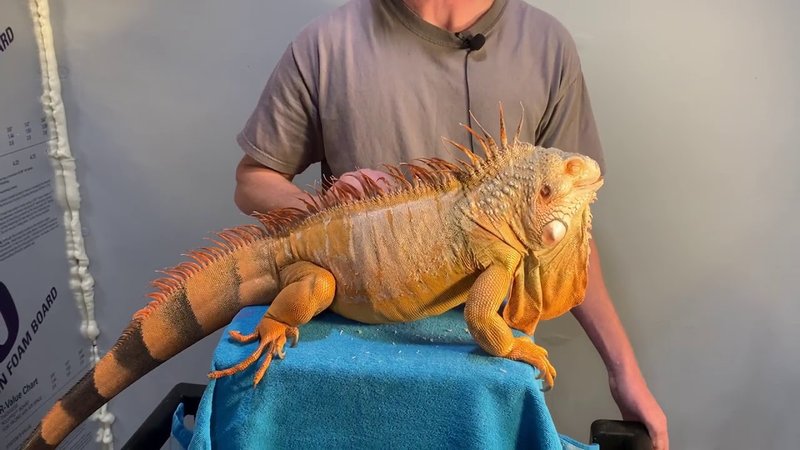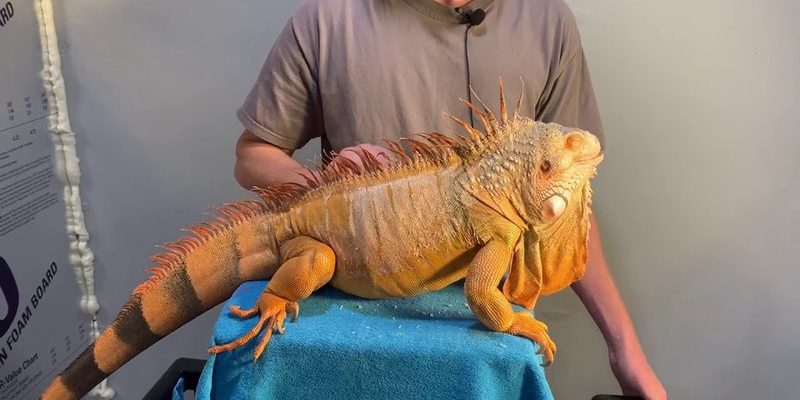
In this article, we’ll dive deep into the size of red iguanas, their growth patterns, and what kind of enclosure they need to thrive. We’ll break it down step by step, so whether you’re a seasoned reptile lover or just curious about iguanas, you’ll have all the info you need to help these amazing creatures feel right at home.
The Size of Adult Red Iguanas
A fully grown red iguana can be quite the sight. Typically, these reptiles reach an impressive length of 4 to 6 feet from snout to tail. That’s about the length of a small dog! It’s important to understand that their size can depend on various factors, including genetics, diet, and care.
Typically, male iguanas are larger than females. Males usually weigh between 10 to 15 pounds, while females can range from 5 to 10 pounds. Think of it like how some breeds of dogs are bigger than others; the same concept applies here. Their growth can also be influenced by the environment they’re kept in. A spacious, well-cared-for enclosure can lead to a healthy, larger iguana!
Growth Stages of Red Iguanas
Red iguanas experience rapid growth, especially during their first few years. When you first get a baby red iguana, they might only be around 12 inches long. But don’t let their small size fool you; they grow quickly! By the end of their first year, they could easily reach 2 to 3 feet in length if provided proper care and diet.
As they mature, their growth will slow down, but they still might add another foot or more to their length in the following years. Diet plays a critical role in this growth. A diet rich in leafy greens, fruits, and high-quality commercial iguana pellets can help them reach their full potential.
Enclosure Requirements for Red Iguanas
Now that we’ve talked about size, let’s discuss where your new pet will live. Setting up a suitable enclosure is vital for their health and well-being. Imagine them needing a home that’s not just a cage, but a mini rainforest!
A good rule of thumb for adult red iguanas is to have an enclosure that’s at least 6 feet long, 3 feet wide, and 4 feet tall. This gives them enough space to roam around and explore. If you can provide more space, that’s even better! The taller height is crucial because red iguanas love to climb. They can often be seen lounging on branches, so adding some climbing structures like branches or shelves can mimic their natural habitat.
Heating and Lighting Needs
Creating a comfortable habitat for your red iguana isn’t just about space. Proper heating and lighting are essential too. Iguanas are ectothermic, which means they rely on external sources to regulate their body temperature. You’ll need to maintain a temperature gradient within their enclosure: a basking area around 95°F and a cooler area around 75°F.
In addition to heating, UVB lighting is crucial for their overall health. This special light helps them synthesize vitamin D3, important for calcium absorption. Without it, they can develop metabolic bone disease. Aim for around 12-14 hours of UVB light per day. So, think of your iguana’s home as a cozy little ecosystem that needs to be just right.
Dietary Considerations for Growth
A well-balanced diet is absolutely essential for a red iguana to grow big and strong. As herbivores, their diet should be mainly composed of leafy greens, vegetables, and some fruits. Collard greens, dandelion greens, and squash are great staples to include.
It’s also a good idea to avoid certain foods that can harm them. For instance, iceberg lettuce has little nutritional value and should be avoided, as well as anything high in oxalates, like spinach. You might be wondering, “How do I ensure they’re getting enough nutrients?” You can supplement their diet with calcium and vitamin D3 powder a couple of times a week to keep them healthy and thriving.
Hydration Needs
Iguanas also need to stay hydrated. In their natural habitat, they often drink from puddles or mist. Providing a water dish large enough for your iguana to soak in can help them stay hydrated. They also enjoy a good misting of water in their enclosure to mimic humidity levels—just like a refreshing rain in the jungle.
Make sure to check the water daily and change it as needed. Clean, fresh water is just as important as their diet!
Common Challenges with Red Iguanas
While red iguanas can make fantastic pets, they do come with their own set of challenges. One common issue is stress, which can arise from improper handling or poor enclosure conditions. If they feel threatened, they might become aggressive or even go off their food. It’s crucial to handle them gently and ensure they feel secure.
Another challenge is understanding their social needs. Iguanas are generally solitary animals and can become stressed if housed with other reptiles. Be mindful of their need for personal space, and always observe how they react to you and their environment.
Signs of a Healthy Iguana
You might be wondering how to tell if your red iguana is healthy. A healthy iguana will have bright eyes, smooth skin, and a strong appetite. They should be active and curious, showing interest in their surroundings. If they’re lethargic, have a dull appearance, or refuse to eat, it might be time to consult a vet that specializes in reptiles.
Ensuring their health requires diligence on your part. Regular vet check-ups can help catch any issues early on. This way, you can ensure your iguana can grow to its maximum size and live a long, happy life.
In summary, red iguanas can grow quite large, reaching around 4 to 6 feet in length, and require a spacious, well-maintained enclosure to thrive. With proper care, including a balanced diet and a suitable environment, you’ll be well on your way to keeping a healthy and happy red iguana. Think of them as both a commitment and a rewarding adventure, one that can lead to a beautiful bond between you and your new pet. Remember, the more effort you put into their care, the more you’ll enjoy your time together. Happy iguana parenting!

